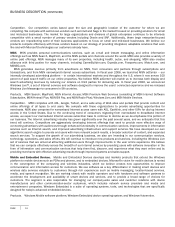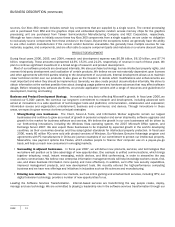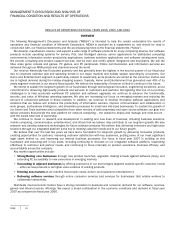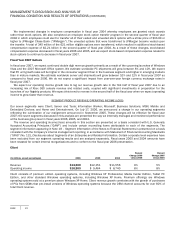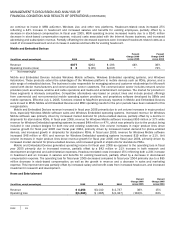Microsoft 2006 Annual Report Download - page 20
Download and view the complete annual report
Please find page 20 of the 2006 Microsoft annual report below. You can navigate through the pages in the report by either clicking on the pages listed below, or by using the keyword search tool below to find specific information within the annual report.
PAGE 19
sales price of our software in the United States and other countries. Operations outside of the United States may be affected by
changes in trade protection laws, policies and measures, and other regulatory requirements affecting trade and investment;
unexpected changes in regulatory requirements for software; social, political, labor or economic conditions in a specific country
or region; and difficulties in staffing and managing foreign operations. While we hedge a portion of our international currency
exposure, significant fluctuations in exchange rates between the U.S. dollar and foreign currencies may adversely affect our net
revenues.
General economic and geo-political risks may affect our revenue and profitability. Inflation, softness in corporate
information technology spending, or other changes in general economic conditions that affect demand for computer hardware
or software could adversely affect our revenue or our investment portfolio. Abrupt political change, terrorist activity, and armed
conflict pose a risk of general economic disruption in affected countries or generally and could require changes in our
operations and security arrangements, thus increasing our operating costs. These conditions may lend additional uncertainty to
the timing and budget for technology investment decisions by our customers.
Catastrophic events may disrupt our business. We are a highly automated business and a disruption or failure of our
systems in the event of a major earthquake, cyber-attack, terrorist attack, or other catastrophic event could cause delays in
completing sales and providing services. Our corporate headquarters, a significant portion of our research and development
activities, and certain other critical business operations are located in the Seattle, Washington area, and we have other
business operations in the Silicon Valley area of California, both of which are near major earthquake faults. A catastrophic event
that results in the destruction or disruption of any of our critical business or information technology systems could severely
affect our ability to conduct normal business operations and, as a result, our future operating results could be adversely
affected.
Acquisitions and joint ventures may have an adverse effect on our business. We expect to continue making acquisitions or
entering into joint ventures as part of our long-term business strategy. These transactions involve significant challenges and
risks including that the transaction does not advance our business strategy, that we don’t realize a satisfactory return on the
investment we make, or that we may experience difficulty in the integration of new employees, business systems, and
technology, or diversion of management’s attention from our other businesses. These factors could adversely affect our
operating results or financial condition.
We have limited insurance. We maintain third party insurance coverage against various liability risks and risks of property
loss. Because of the unavailability or high cost of conventional insurance arrangements, we have entered into captive insurance
arrangements for the purpose of protecting against possible catastrophic and other risks not covered by traditional insurance
markets. As of June 30, 2006, the face value of captive insurance arrangements was $2.0 billion. Actual value at any particular
time will vary due to deductibles, exclusions, other restrictions, and claims. While we believe these arrangements are an
effective way to insure against liability and property damage risks, the potential liabilities associated with the risks discussed in
this report or other events could exceed the coverage provided by such arrangements.
Improper disclosure of personal data could result in liability and harm our reputation. We store and process significant
amounts of personally identifiable information as we offer a large array of products and services to our customers. It is possible
that our security controls over personal data, our training of employees and vendors on data security, and other practices we
follow may not prevent the improper disclosure of personally identifiable information. Such disclosure could harm our reputation
and subject us to liability under laws that protect personal data, resulting in increased costs or loss of revenue. Our software
products also enable our customers to store and process personal data. Perceptions that our products do not adequately
protect the privacy of personal information could inhibit sales of our products.
Other risks that may affect our business. Other factors that may affect our performance may include:
• sales channel disruption, such as the bankruptcy of a major distributor;
• our ability to implement operating cost structures that align with revenue growth;
• the continued availability of third-party distribution channels for MSN service and other online offerings; and
• disruption to our operations as a result of weather-related events.



